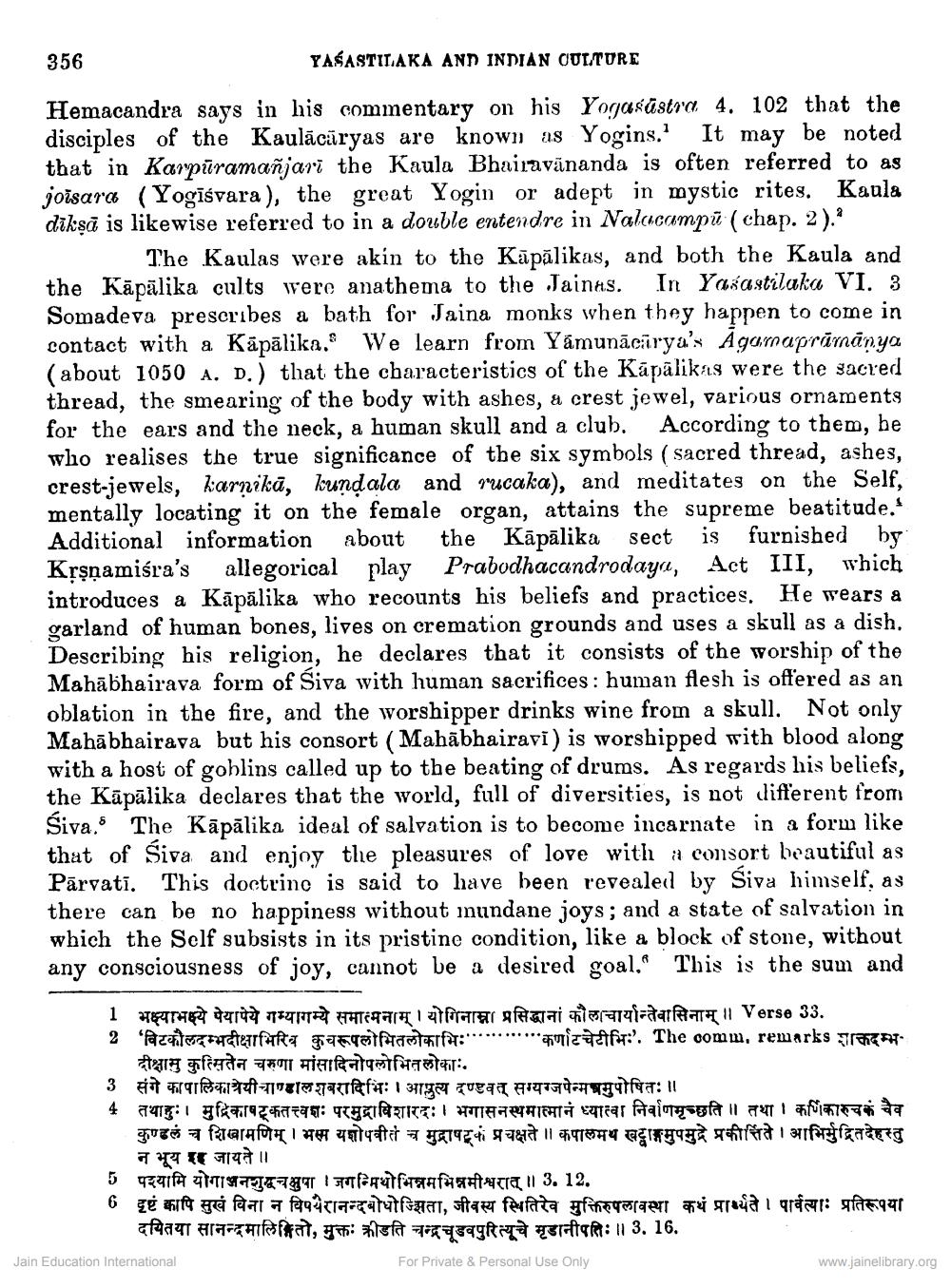________________
356
YAŠASTILAKA AND INDIAN QUINTURE
Hemacandra says in his commentary on his Yogašāstra. 4. 102 that the disciples of the Kaulācāryas are known as Yogins. It may be noted that in Karpūramañjari the Kaula Bhairavānanda is often referred to as joīsara (Yogīśvara), the great Yogin or adept in mystic rites. Kaula dikşā is likewise referred to in a double entendre in Nalucampū (chap. 2).*
The Kaulas were akin to the Kāpālikas, and both the Kaula and the Kāpālika cults were anathema to the Jainas. In Yašastilaka VI. 3 Somadeva prescribes a bath for Jaina monks when they happen to come in contact with a Kāpālika. We learn from Yamunācārya's Agamaprāmanya (about 1050 A. D.) that the characteristics of the Kāpālikas were the sacred thread, the smearing of the body with ashes, a crest jewel, various ornaments for the ears and the neck, a human skull and a club. According to them, be who realises the true significance of the six symbols ( sacred thread, ashes, crest-jewels, karnikā, kundala and rucaka), and meditates on the Self, mentally locating it on the female organ, attains the supreme beatitude. Additional information about the Kāpālika sect is furnished by Krşņamiśra's allegorical play Prabodhacandrodaya, Act III, which introduces a Kāpālika who recounts his beliefs and practices. He wears a garland of human bones, lives on cremation grounds and uses a skull as a dish. Describing his religion, he declares that it consists of the worship of the Mahābhairava form of Śiva with human sacrifices: human flesh is offered as an oblation in the fire, and the worshipper drinks wine from a skull. Not only Mahābhairava but his consort (Mahābhairavi) is worshipped with blood along with a host of goblins called up to the beating of drums. As regards his beliefs, the Kāpālika declares that the world, full of diversities, is not different from Siva. The Kāpālika ideal of salvation is to become incarnate in a form like that of Siva and enjoy the pleasures of love with a consort beautiful as Pārvatī. This doctrine is said to have been revealed by Siva himself, as there can be no happiness without mundane joys; and a state of salvation in which the Self subsists in its pristine condition, like a block of stone, without any consciousness of joy, cannot be a desired goal. This is the sum and
4
ay
1 THT dan 173CTITRITTHCAT i afirmar afhai hierailar TH 11 Verse 33. 2 "acante interfata gestastarfar: .......*** aft:'. The comm, remarks ***
दीक्षामु कुत्सितेन चरुणा मांसादिनोपलोभितलोका.. 3 संगे कापालिकाग्रेयीचाण्डालशबरादिभिः । आप्लत्य दण्डवत् सम्यग्जपेन्मत्रमुपोषितः ।।
तथाहुः। मुद्रिकाषट्कतत्त्वशः परमुद्राविशारदः । भगासनस्थमात्मानं ध्यात्वा निर्वाणमृच्छति ॥ तथा । कर्णिकारुचकं चैव कुण्डलं च शिखामणिम् । भस्म यज्ञोपवीतं च मुद्राषट्क प्रचक्षते । कपालमथ खदाङ्गमुपमुद्रे प्रकीर्तिते । आभिर्मुद्रितदेहस्तु
न भूय इह जायते ।। 5 alfa 1474 Flatforwafa tret 11 3. 12. 6 दृष्टं कापि सुखं विना न विपथरानन्दबोधोज्झिता, जीवस्य स्थितिरेव मुक्तिरुपलावस्था कथं प्राय॑ते । पार्वत्याः प्रतिरूपया
दयितया सानन्दमालिहितो, मुक्तः क्रीडति चन्द्रचडवपुरित्यूचे मृडानीपतिः। 3. 16. Jain Education International For Private & Personal Use Only
www.jainelibrary.org




